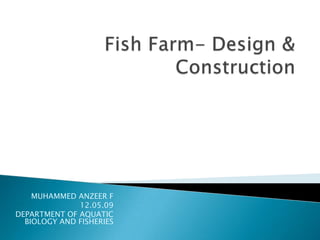
FISH FARM - DESIGN & CONSTRUCTION
- 1. MUHAMMED ANZEER F 12.05.09 DEPARTMENT OF AQUATIC BIOLOGY AND FISHERIES
- 2. Since ancient times, fish have been held in a wide variety of man- made structures. These structures were built using simple methods and readily available materials. The fish or other aquatic crop were cared for by the fish farmer and relied upon as an important source of protein for their families. Typical fish farm was developed by forming small ponds by hand, or an even simpler method of trapping tidal water flow in estuaries by building simple water retaining structures. INTRODUCTION
- 3. Water availability Temperature Soil Terrain transportation Electricity Free of pathogens Pollution Trash fish any other undesirable organism SELECTION OF A REGION
- 4. Open space for aeration Future expansion of the project susceptibility of the site to flooding availability of suitable manpower to operate the farm proximity of markets ability to secure the site against poaching and sabotage potential impact on neighbours and environment. In general, knowledge of local geography and local and regional hydrology, geology, climate and weather
- 5. Extensive Earthen pond Built to farm fish, specific and shape; water level and water quality monitored and maintained; some supplementary feeding; predator control. Intensive Tanks, raceways, troughs, cages, small earthen ponds Complete feeding. Generally, prepared feeds; highly managed ponds with regular water exchange/management Extensive and Intensive Systems
- 6. Design of earthen ponds Earthen ponds comprise the major capital investment in aquaculture facilities throughout the world. More than 90 per cent of the total global production is from ponds. The ponds and buildings should be laid out for efficient and economic operation and the best utilization of the land. Construction of ponds and drainage systems should be planned and supervised by both an aquaculturist and an engineer, particularly if a large system is to be constructed.
- 8. Type and Shape There are three basic structural types. excavated pond in which earth is removed and used for building the banks. This type of pond can be constructed on flat or undulating land. Levee ponds are constructed on very flat land and are similar in structure to rice bays except that the banks must be high enough to contain the necessary depth of water. Gully or ravine ponds are restricted to hilly country and are constructed by damming valleys or gullies. Ponds should be square or rectangular to make the most efficient use of available land. It is more economical to construct square ponds; however, rectangular ponds are easier to manage.
- 10. Buildings and equipment 1.office 2.toilet and washroom 3.aboratory 4.meal room 5.general workroom with tanks for holding, sorting, quarantining and treating fish, with vehicular access plant room with filters and airblowers store rooms for chemicals, feed, equipment garages for vehicles, boats, pumps, traps, nets, mowers workshop for repairing and making equipment handling and packaging room for preparing fish for packaging and dispatch
- 12. Supply and drainage inlet and outlet. Both should be screened; the inlet to prevent the entry of trash fish and other undesirable aquatic fauna, and the outlet to prevent the loss of stocked fish. Construct ponds so that they can be drained individually, completely and rapidly. This will enable the removal of all fish during harvesting and facilitate efficient management, particularly when water quality and disease problems occur.Each pond should have a deep (at least 2 metres) and a shallow (1- metre) section; however, the preferred depth varies with the species and the locality. (Buffer)
- 13. Build banks with slopes of about 3: 1. Line the banks with topsoil and plant with grasses to ensure stability and prevent erosion. There is a large variation in the size of earthen ponds used in aquaculture throughout the world and authorities disagree on the optimum size of ponds.
- 14. The success of any production system in industry and agriculture relies heavily on design and construction. A well designed and constructed system provides the foundation for successful operations. Even the best management techniques can do little to optimize production in poorly designed and inadequately constructed systems. This applies to ponds at all levels of management. CONCLUSION
